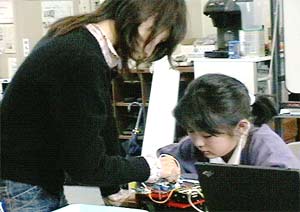
Abstract
At Saitama University, a few elementary schools and a growing number special afternoon schools in Japan, a new, exciting concept for "optimal learning" is being developed. In this article researcher, Frans
But the programmes also has something to offer the involved university students, who gets a chance to practice, rehearse, communicate, "turn around" and reflect on their knowledge and coming profession, often in "alternative ways" when confronted with the "undisciplined" questions and solutions offered by children.
At the core of the new concept is a kind of collaborative learning setup where pupils (children participating in the mentioned activities) and teachers (mainly university students) both learn and develop. Traditional educational roles change dynamically during the learning process, "flow" periods are frequent and conflicts, boredom or performance pressures seldom. Another achievement of these "optimal learning environments" could be described as "action competence", a construct that deals with achieving "deep" knowledge going beyond mere reproduction and memorizing, and which has learning perspectives involving creativity, innovation and an expanded understanding of problems (here technical / scientific), their causes, effects and solutions. Obtaining "action competence" can also be linked to "flow"-processes.
IT-class at Keio Yochisha Elementary School
It's a Tuesday afternoon in the crisp Japanese winter. A group of 10-12 year old kids from Keio Yochisha Elementary [1] is entering a futuristic, inspiring, un-even shaped - and yet very child centered - classroom for nearly two hours of voluntary cross-curricular IT-class that goes on for a year, every Tuesday at this time. "Manga" and soccer posters on the wall mingle with flow charts, children's drawings and other standard classroom wall decorations like white boards, timetables and announcements for meetings.
Otherwise the classroom is completely unlike anything I have ever seen. The room itself is kind of pentagonal shaped - shelves and boxes of computer hard- and software + all kinds of electronic gear and gadgets are piled along the walls. Spread all over the floor is boxes of Lego bricks - mostly - from series like Lego Technic, Mindstorms and Robolab. In one corner there's a huge open circle on the floor - reserved for concrete tests, experiments and rounds of ordinary play with computer controlled vehicles and robots.
In another corner we find a rectangular shaped racing and "maze" field for exercising devices for "Lego First League" - a robots invention scheme designed by Lego Educational Division for schools. All in all a very inspiring and well fit room for crating an "optimal learning environment".
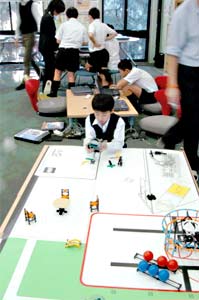
They all seem to be very dedicated to and engaged in the activities - and without any instruction they themselves start finding their files on the computers or look around for concrete construction tools and bits. No need for the teachers to give them any orders or messages at this stage.
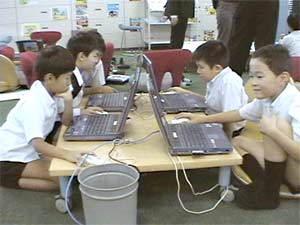
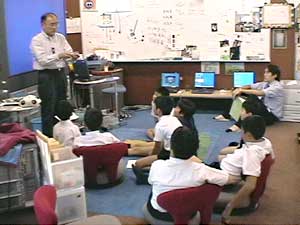
The children keep changing their physical placement in the room - moving freely around from group discussions, concrete robot construction on the floor, teacher-student whiteboard sessions like the one mentioned, testing and playing periods at the robot "maze" field (shown at picture above) or programming at the laptops.
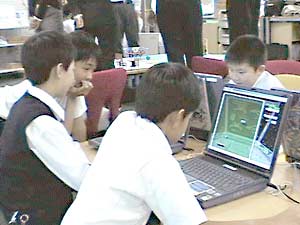
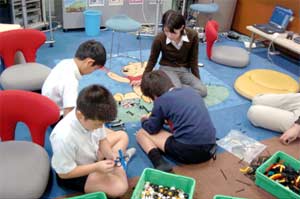
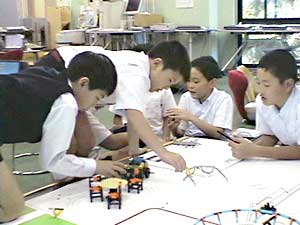
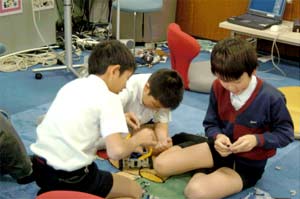
A "flow" environment
By using a construct developed by the American researcher, Mihaly Csikszentmihalyi, "flow" [3] is a unique, enjoyable, worth-while psychological state of continual and committed attention:
"Flow is an intrinsically motivated, task-focused state characterized by full concentration, a change in the awareness of time, feelings of clarity and control, a merging of action and awareness and a lack of self-consciousness. The experience is triggered by a good fit between a person's skills in an activity and the challenges afforded by the environment. Flow has been shown to promote learning and development because experiences of total concentration are intrinsically rewarding, and they motivate students to repeat an activity at progressively higher levels of challenge". [4]
It appeared to me that at the mentioned IT-class at Keio Yochisha as well as at the "kids on campus" scheme at Saitama University + at the LEC afternoon classes [5] in Jiyugaoka and Kichijoji the students often had periods of flow.
The picture below shows such a flow situation - a very concentrated group of students, deeply absorbed in their robot construction experiments.
Usually, if you want to find out if people are actually in flow in a certain situation, a method to use is simply to ask them afterwards. But in this case I didn't interview the students - how then to determine if they were actually in flow?
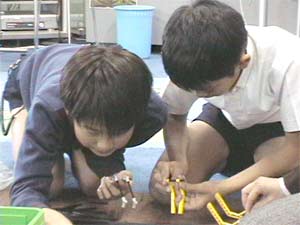
Also, my own research conducted at schools in Scandinavia (see articles about that at www.legolearning.net) - as well as the research conducted by e.g. prof. Mihaly Csikszentmihalyi (Claremont Graduate University) and prof. Kevin Rathunde (Utah University) - show that periods of such project work learning, characterized by high levels of student interest, influence and self-direction combined with flexible work and study methods, are much more likely to produce flow-experiences than traditional teaching where all the pupils sit in the classroom, listening to the teacher most of the time, only interrupted by individual work on class assignments from time to time.
Almost all the pupils I have interviewed, at Scandinavian schools, report "school-flow" in connection with periods dominated by such "project work learning" - or, alternatively in more traditional learning settings in normal classes, the pupils report flow experiences during lessons with practical and /or creative subjects like art, music, computing or gymnastics. It should be noted, however, that flow also can occur even at long periods of traditional teacher dominated classroom teaching - in that case, the children often associate their flow states to special engaging skills on the part of the teacher.
Action competence
Another more general outcome of the mentioned learning environment, could be described "action competence", a construct that deals with achieving "deep" knowledge, going beyond mere reproduction and memorizing. A concept that has "wider" learning perspectives, involving the development of competencies like creativity, innovation and an expanded understanding of problems (here technical / scientific), their causes, effects and solutions.
Thus "action competence" can be seen as a core competence for the future, where individual and group innovation and creativity will be essential for institutions, companies and whole societies as a way of solving ever-more complex problems, implementing necessary adjustments, catching up and developing in a world of rapid change, constant emerging new, unforeseen problems and technological advance.
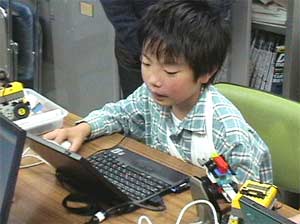
The four dimensions are:
| 1. | Effect knowledge. What kind of problem could occur if I do this wrong? Knowledge of effects. |
| 2. | Cause knowledge. Why do we have this problem? Knowledge about causes. |
| 3. | Change or solution knowledge. How do we solve this problem or change the conditions that caused it? |
| 4. | Vision knowledge. Could there be alternative solutions? |
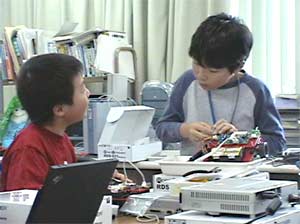
|
||||||||||
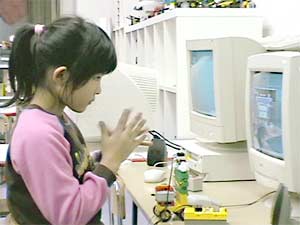
Flow conditions met at Jiyugaoka Lego Education Center [7]
On the same afternoon as the 5th & 6th graders gathered at the Keio Yochisha Elementary, Tokyo, "somewhere else in town" other afternoon classes begin their sessions at Jiyugaoka and Kichijouji Lego Education Centers (LEC's). Attending different groups according to age (ranging from 3-14 years) the children engage in activities, similar to the ones described at the Keio Yochisha, adjusted of course to age or experience levels, i.e. periods of almost free play are more frequent here.
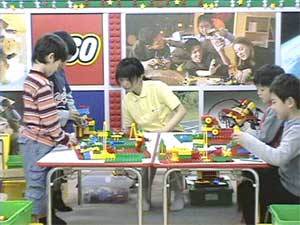
|
In spite of the seemingly many periods of "almost free play" and "playful learning activities" all activities & teaching at the LEC's are organised and structured according to the Lego Educational Division global science curriculum that has in-built evaluation & documentation of each child's cognitive & social development.
Most activities include, one way or the other, the use of computers at an interesting, inter-active way - combing software like "robolab" and "My make believe Castle" + concrete construction materials / toys + discussions. The university student teachers do a very good job, balancing activities between:
|
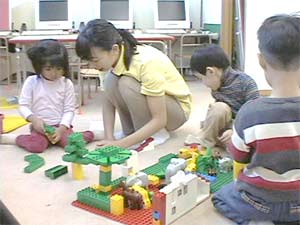
Also at the LEC's Csikszentmihalyis general flow-conditions were often met:
|
||||||||||||||||||
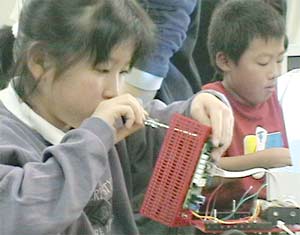
Conclusion
It indeed looks like a very worthwhile, inspiring and new way of organising learning environments is being developing at the schools mentioned in this article. In these environments, traditional curriculum goals and standards are met and honoured in a very good way - without the pitfalls of boredom, anxiety and / or performance pressure that you see in many other learning environments - not just for kids, but really for everyone learning. And perhaps, even more important, at the same time this way of organising and structuring education also enhances "flow", "creative thought", "collaboration" and "action competence" - all crucial, not just for individuals but also for institutions, companies and whole societies, for being able to prosper and develop in the 21st century. Unfortunately these competencies are rarely associated with normal learning environments. Inspiration for change can be found in Tokyo.
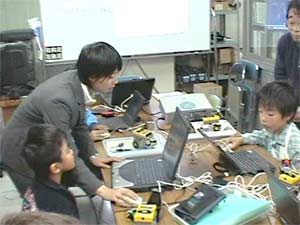
---------------------------------------------------------------
[1] www.yochisha.keio.ac.jp (Japanese)
[2] Mr. Masao Ishihara runs an educational, consultative business of his own. Check it out at: www.mdstorm.com (Japanese)
[3] At www.legolearning.net you can read more about Mihaly Csikszentmihalyi and "flow" in the article "Mihaly Csikszentmihalyi - creator of the flow theory".
[4] Rathunde, K. (2003): A Comparison of Montessori and Traditional Middle Schools: Motivation, Quality of Experience, and Social Context. In "The Natma Journal", Vol. 28, No.3, Summer 2003.
[5] LEC = Lego Educational Centers. You can read more about the LEC classes in Japan at www.legoeducation.jp (Japanese)
[6] Bjarne Bruun Jensen, researcher at the Danish University of Education, www.dpu.dk. He is also a consultant for the WHO within the fields of Health Education and Health Promotion. He describes the mentioned model in "Participation, Commitment and Knowledge as Components of Pupils' Action Competence" in Critical Environmental and Health Education Research Issues and Challenges (2000), Published by the Danish University of Education, Copenhagen.
[7] www.legoeducation.jp/locations/jiyuugaoka.html (Japanese)














